
Incheon, formerly Jemulpo or Chemulp'o (Korean: 제물포) until the period after 1910, officially the Incheon Metropolitan City (인천광역시), is a city located in northwestern South Korea, bordering Seoul and Gyeonggi Province to the east. Inhabited since the Neolithic, Incheon was home to just 4,700 people when it became an international port in 1883. Today, about 3 million people live in the city, making it South Korea's third-most-populous city after Seoul and Busan.

The Korea Railroad Corporation is the national railway operator in South Korea. It is branded as KORAIL (코레일) and changed its official Korean name in November 2019. Currently, KORAIL is a public corporation, managed by Ministry of Land, Infrastructure and Transportation.

Yongin is a city in the Seoul Capital Area, the largest in Gyeonggi Province, South Korea. With a population over 1 million, the city has developed rapidly since the 21st century, recording the highest population growth of any city in the country. Yongin is home to Everland and Caribbean Bay, South Korea's most popular amusement and water parks. The city is also home to the Korean Folk Village, the largest of its kind. Yongin is a multi-nuclear city with multiple urban centers, not a single nuclear structure, and Giheung District crosses the Yeongdong Expressway and Dongbaek, while Suji District crosses Pungdeokcheon Stream and Jukjeon.
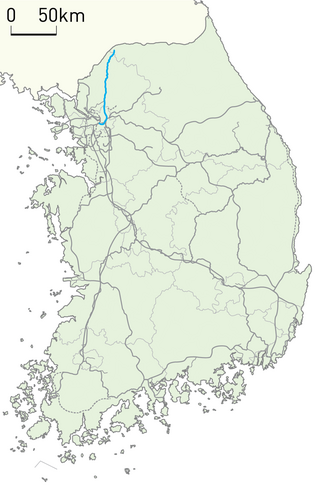
The Gyeongwon Line is a railway line serving northeastern Gyeonggi Province in South Korea. The line is operated by Korail. The name of the line came from Gyeongseong (Seoul) and Wonsan, the original terminus of the line, in what is now North Korea.

The Gyeongui Line is a railway line between Seoul Station and Dorasan Station in Paju. Korail operates the Seoul Metropolitan Subway service between Seoul Station and Dorasan Station.
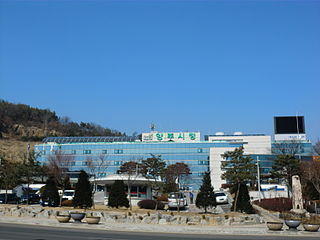
Yangju is a city in Gyeonggi Province, South Korea. Yangju is located south of Dongducheon and north of Uijeongbu, not far from Seoul.
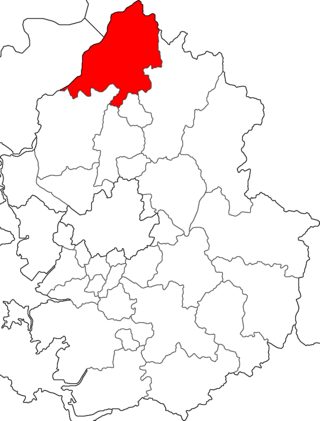
Yeoncheon County (Yeoncheon-gun) is a county in Gyeonggi Province, South Korea. The county seat is Yeoncheon-eup (연천읍) and sits on Gyeongwon Line, the Korail railroad line connecting Seoul, South Korea (ROK), with North Korea (DPRK).

Seoul Subway Line 1 of the Seoul Metropolitan Subway is a rapid transit and commuter rail line which links central Seoul, South Korea to Yeoncheon in the northeast, Incheon in the southwest, and Sinchang via Suwon and Cheonan in the south. The central underground portion of Line 1, running underneath Sejongno, Jongno, and Wangsan-ro avenues along Seoul's traditional downtown area, is the oldest subway-operated section in the Seoul Metropolitan Subway system. Its branches and services cover a large part of the Seoul Capital Area; totaling 218.3 km (135.6 mi) in route length.

Seoul Subway Line 2, also known as the Circle Line, is a circular line of the Seoul Metropolitan Subway. The line running clockwise is called the "inner circle line" and the counter-clockwise line is called the "outer circle line". This is Seoul's most heavily used line, and consists of the main loop, the Seongsu Branch and the Sinjeong Branch for a total line length of 60.2 km (37.4 mi). The Line 2 loop is the third longest subway loop in the world after Moscow Metro Bolshaya Koltsevaya line and Beijing Subway Line 10. In 2019, Line 2 had an annual ridership of 812 million passengers or 2.2 million passengers per day.

Seoul Subway Line 9, operated by Seoul Line9 Operation, is a subway line in Seoul, part of the Seoul Metropolitan Subway. The line runs east from Gaehwa station or Gimpo International Airport station along the south bank of the Han River towards VHS Medical Center in Gangdong. In 2019, Line 9 had an annual ridership of 225 million or about 616,000 people per day.

Yeongdeungpo District is an administrative district in southwest Seoul, South Korea. Although the origin of the name is uncertain, the first two syllables are thought to be from "yeongdeung" (靈登) or "divine ascent", a shamanic rite. The third syllable is "po", representing the bank of a river (浦), referring to the district's position on the Han River. The 2006 population was 408,819.

The Commuter Train was a class of short-run commuter trains operated by Korail, the national railroad of South Korea. They operated once or twice daily in each direction, along a few tens of kilometers of track. They provided an important function for many smaller rural communities, which often lack good transit connections. Commuter Train operations on the Gyeongwon line was temporarily suspended its operation on April 1, 2019, due to the construction and partial electrification of the line for the Soyosan-Yeoncheon extension of Seoul Subway Line 1. They were permanently suspended on December 16, 2023, after the opening of the Yeoncheon extension, and due to the old age of CDC trains. This effectively ended regular train service north of Yeoncheon Station, with the provincial government of Cheolwon lodging a complaint. Commuter trains last operated on the Gwangju Line in Gwangju between GwangjuSongjeong and Gwangju station, from January 1, 2020, until December 17, 2023, permanently being phased out due to the old age of CDC trains.

Geumjeong Station is a ground-level metro station on lines 1 and 4 of the Seoul Subway network in South Korea. The station is in Gunpo, a city approximately 15 km (9.3 mi) south of Seoul in Gyeonggi Province, between the cities of Anyang and Suwon. The name means that the land is covered with waves everywhere and that the water wets women's clothes.
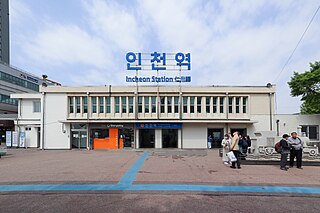
Incheon Station is the western terminus railway station of the Suin–Bundang and Gyeongin lines of the Seoul Metropolitan Subway. The station is in the Bukseong neighborhood of the Jung District, Incheon, South Korea and is approximately 20 kilometers west of Seoul. Established in 1899 under the Korean Empire as Chemulpo Station, Incheon Station is the oldest train station in the Seoul Capital Area. During the Japanese occupation of Korea, the station was briefly named Hainchon Station and the original station building was destroyed during the Korean War. Service for the old Suin Line began in 1937 and ended in 1995; the new Suin Line was extended to the station in 2016. Service for the Gyeongin Line began in 1974.

Soyosan Station is a ground-level metro station on Line 1 of the Seoul Subway in Sangbongam Dong, Dongducheon, South Korea. It is named after the nearby Soyosan (587 m), a mountain beside the U.S. Army base Camp Casey. It is on this mountain, at the Jajae'am Hermitage, that the Buddhist Saint Wonhyo is said to have reached enlightenment.
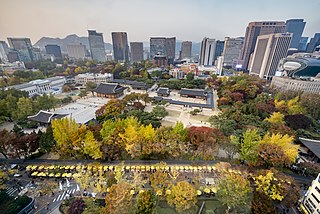
Seoul, officially Seoul Special Metropolitan City, is the capital and largest city of South Korea. The broader Seoul Capital Area, encompassing Gyeonggi Province and Incheon Metropolitan City, emerged as the world's sixth largest metropolitan economy in 2022, trailing behind Paris, San Francisco, Los Angeles, Tokyo, and New York, and hosts more than half of South Korea's population. Although Seoul's population peaked at slightly over 10 million, it has gradually decreased since 2014, standing at approximately 9.97 million residents as of 2020. Seoul is the seat of the South Korean government.

Seojeongni Station is a station in Seojeong-dong, Pyeongtaek, South Korea. Mugunghwa-ho trains running on the Gyeongbu Line stop here. Additionally, services on Seoul Subway Line 1 have been calling at this station since 2005. Its station subname is Kookje College.

Jeongok Station is a ground-level metro station on Line 1 of the Seoul Subway in Yeoncheon, South Korea.

DMZ Train is a South Korean excursion train operated by Korail. The train began operations in 2014 and transports tourists from Seoul to train terminals closest to the Korean Demilitarized Zone. The service was suspended in 2019 and has not yet resumed operation. Due to the aging issue of the trains, the DMZ Train ended its operation on 28 December 2023.

Cheongsan station (Korean: 청산역) is a ground-level metro station on Line 1 of the Seoul Subway in Yeoncheon, South Korea.





















